There is a palpable sense of anxiety around attracting, engaging and retaining talent in today’s labour market. Some 69% of companies have reported talent shortages – representing a 15-year high – and 40% of workers are ‘somewhat likely’ to leave their roles in the next 3 to 6 months, according to a survey of more than 6,000 employers and employees from Australia, Canada, Singapore, the United Kingdom, and the United States by McKinsey & Company.
It’s easy to understand why HR leaders are concerned.
New terms such as the ‘Great Resignation’, ‘Big Quit’, ‘Great Reshuffle’, ‘Great Attrition’ ‘Great Reset’, ‘Great Reimagination’ and ‘Great don’t come back into the office’ have been bandied about over the past year. All these phrases refer to a seismic shift in how people think about work in the wake of the COVID-19 pandemic.
So, how exactly is the ‘Great Resignation’ affecting talent attraction, engagement and retention in practical terms, and what does this mean for your people strategy?
It can be difficult to make sense of the data, so we have examined the numbers behind the headlines and explored their real-world impact.
Read on to gain the latest insights and practical advice to ensure you are on course to secure and hold onto the best talent for your business. For example:
Why are employees choosing to leave their roles?
What are the current challenges in talent retention?
What are the most innovative talent attraction, engagement and retention strategies?
We take a deep dive into the latest trends and most effective solutions (it’s clearly more complex than simply increasing pay and benefits).
Senior leaders and HR professionals are expressing concern that competition for top talent will adversely impact the ability of organisations to grow. Specifically, they have noted the following trends:
High numbers of employees are leaving their roles, often without lining up a new job in advance.
Recruitment challenges have been exacerbated by the COVID-19 crisis, with many organisations choosing not to recruit during the pandemic.
Staff retention also decreased, with fewer organisations undertaking specific initiatives to improve retention and employers experiencing a higher level of voluntary turnover than in previous years.
Power has shifted from employers to employees in the wake of the pandemic – and there is particular competition for specialist tech and human skills.
Let’s look at the data behind the headlines to understand these trends.
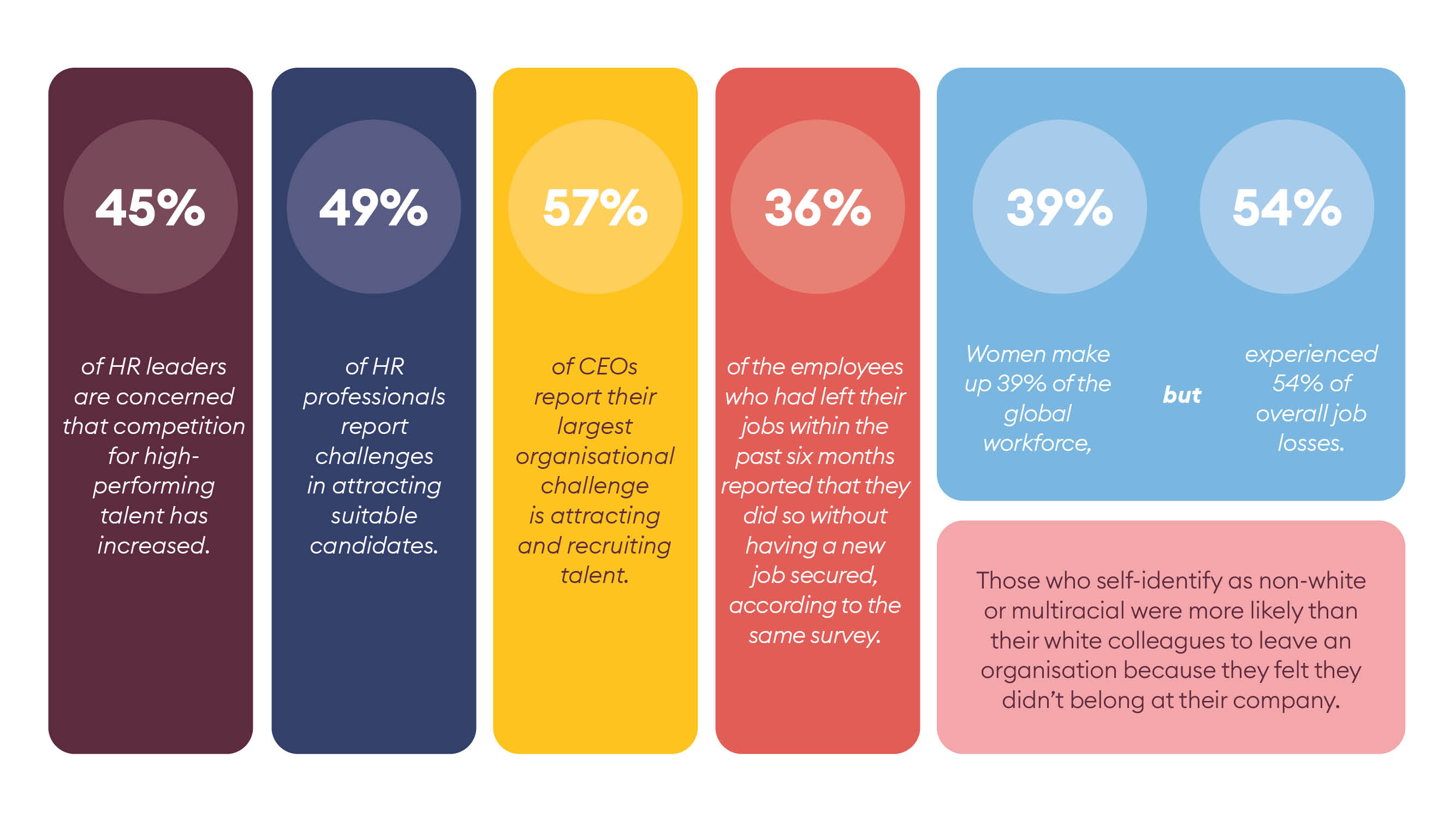
45% of HR leaders are concerned that competition for high-performing talent has increased.
49% of HR professionals report challenges in attracting suitable candidates.
57% of CEOs report their largest organisational challenge is attracting and recruiting talent.
53% of employers who responded to the McKinsey & Company survey reported higher levels of voluntary turnover than in previous years.
4.5m people in the US resigned from their role in November 2021 according to the Bureau of Labour Statistics.
1.6 million people were unemployed in the UK in the summer of 2021, while there were 1.66 million active job adverts at that time.
According to the March 2021 Microsoft Work Trend Index, 40% of the global workforce were considering leaving their employer in 2021.
36% of the employees who had left their jobs within the last 6 months reported that they did so without having a new job secured, according to the same survey.
Across the workforce, the impact of the pandemic has not been felt equally:
Women make up 39% of the global workforce, but they experienced 54% of overall job losses.
Women’s jobs were 1.8 times more vulnerable to the crisis than men’s jobs, according to McKinsey & Company. (Women and men tend to cluster in different occupations in both mature and emerging economies).
60% of generation Z say they are “merely surviving” or “struggling” at work, due to a lack of networking opportunities, difficulty achieving work-life balance and minimal engagement or motivation.
Many 16-25 year-olds struggled to maintain employment during the first stretch of the COVID-19 pandemic (recently, more young people within this demographic have been able to find sustainable work).
Susanne Braun, Professor in Leadership at Durham University Business School.
Listen to insights from Susanne in our ‘Hybrid working: How is the new normal changing leadership and talent attraction?’ podcast.
Why is talent retention important? If you don’t know why people are leaving your organisation, you can’t find ways to prevent this. It’s important to do so, because keeping valuable talent is vital to an organisation’s productivity and performance.
In addition, retaining and engaging high-performing employees is more efficient (and cost-effective) than recruiting, onboarding and embedding new talent of the same quality.
Meanwhile, from the employee perspective, changing jobs regularly can impact negatively on people’s physical and mental health, due to the strain of job searching and onboarding with a new employer.
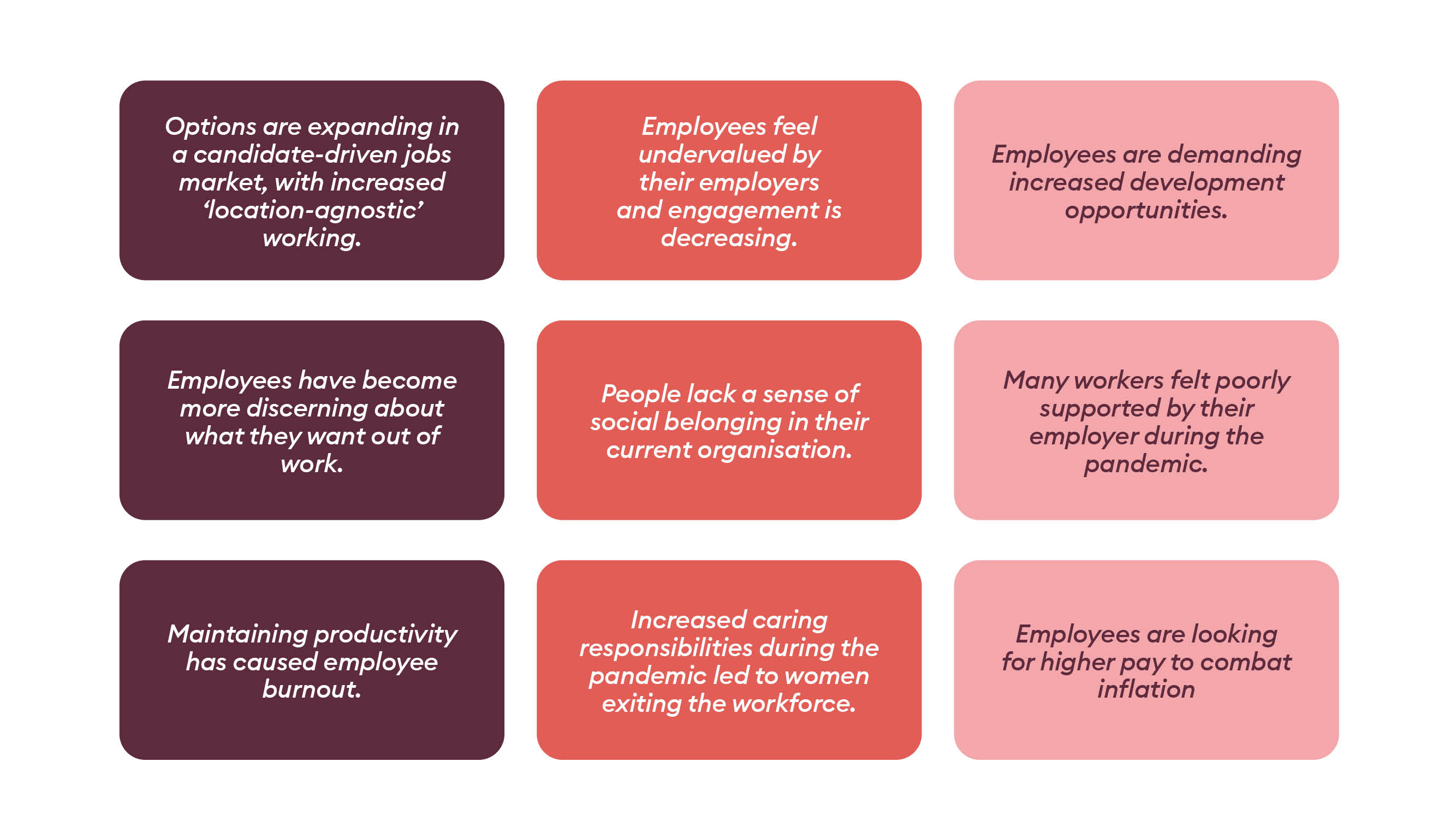
There has been debate among experts as to what is driving the ‘Great Resignation’, with several factors cited:
Here are some specific reasons:
Darren Lancaster, CEO of Americas and EMEA at Hudson RPO.
Listen to insights from Darren in our
‘Hybrid working: How is the new normal changing leadership and talent attraction?’ podcast.
Ensuring your talent strategies continue to attract, engage and retain a diverse workforce involves scrutinising your purpose and culture, as well as financial and other benefits.
Understanding the views of younger workers is important because the number of Gen Z workers (anyone born from 1997 onwards) is set to triple by 2030. But you may have four generations represented within your workforce, all with differing expectations.
To help with workforce planning, Ian C Woodward, a professor of management practice at France’s INSEAD business school, encourages leaders ask themselves the question: “How should we work in the future, what talent will we need, and what will this talent want?”.
Looking at your organisational goals in relation to your overall employee value proposition – including opportunities for learning and development, employee wellbeing and flexible working – all help answer these questions. Find out how employers can harness these elements to attract and retain talent.
The challenge for HR leaders is to develop talent attraction/acquisition, engagement and retention strategies that reflect both business goals and employee concerns. This involves re-examining your expectations of employees, and looking at them holistically as human beings.
With this in mind, Louisa Moreton, partner at Finsbury Glover Hering, advises employers to reflect on how they can make their structures more human: “The truth is, we’ve all been dexterous for years, moulding ourselves to fit rigid, inflexible organisational structures,” she says. “I think what’s happening now is that organisational structures are being reshaped to fit around us.”
Let’s explore some of the elements of successful talent attraction, engagement and retention strategies that enable companies to reshape themselves around their people.
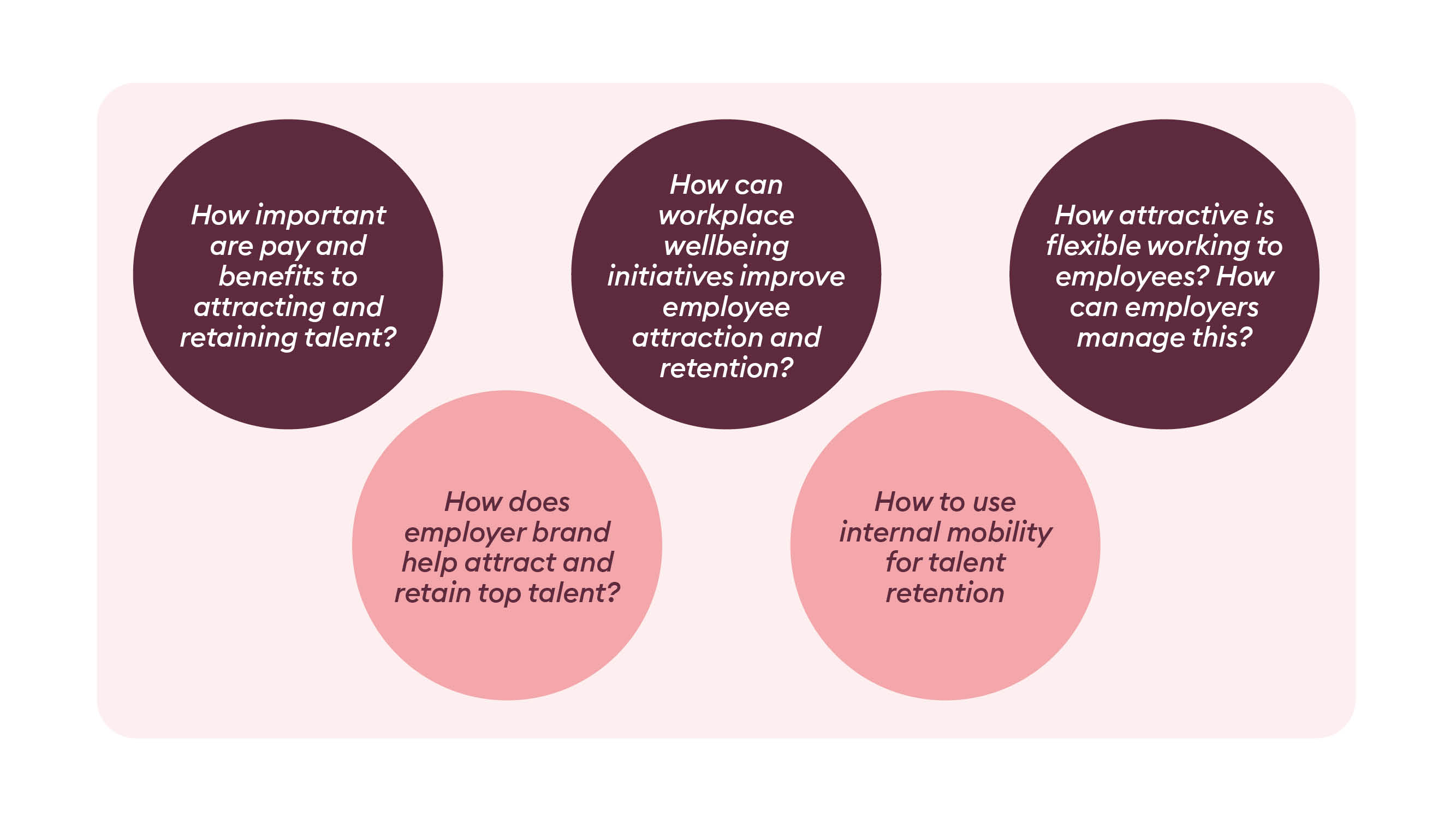
In March 2022, Neil Carberry, chief executive of the Recruitment and Employment Federation, noted the real-terms fall in average pay compared with last year. The fierce competition for talent is leading to large increases in rates of starting pay for permanent and short-term staff.
While money isn’t the only (or even key) factor in attraction or retention, with inflation spiralling, providing a competitive pay and benefits package will clearly decrease the risk that your top talent will search for employment elsewhere.
However, LinkedIn has recently found that employees value wellbeing over compensation and benefits packages, quipping “work-life balance trumps even bank balance for job seekers”.
Susanne Braun, Professor in Leadership at Durham University Business School.
While employees have maintained or exceeded productivity throughout the pandemic, this has resulted in employee burnout. As workers’ daily stress has increased, the onus is on HR leaders to tackle this to prevent employee disengagement.
49% of employers are taking steps to retain employees through improving work-life balance. At the start of the pandemic, employers put in a raft of measures to support employee wellbeing, but as Caroline Roberts, interim HR director of the Confederation of British Industry (CBI) points out, many of these have waned: “At the very start of the pandemic, we saw managers getting teams together virtually, there’d be the Zoom drinks and things like that… A lot of that has tailed off.”
How can companies help employees achieve a better work-life balance? Employers need to adapt their approach to wellbeing to support employees who are experiencing poor wellbeing or mental health as a result of COVID-19 and its impact on the economy and wider society.
A carefully considered wellbeing package is particularly attractive to prospective employees. Workplace cultures that prioritise mental health and wellbeing are vital for Gen Z.
Mental health organisations, such as Mind, have created resources for employers to support staff mental health and wellbeing during the COVID-19 pandemic and beyond. These reflect the specific challenges in the workplace caused by the pandemic and include guides on how to manage a remote team, cope with redundancy and return to work.
Caroline Roberts is the interim HR Director of the Confederation of British Industry (CBI).
Listen to insights from Caroline in our ‘Hybrid working: How is the new normal changing leadership and talent attraction?’ podcast.
One of the key drivers of employee wellbeing is flexibility at work. Around 71% of employers advertise at least some vacancies as ‘open to flexible working’ and 54% are offering greater work flexibility to address recruitment difficulties.
Flexibility is particularly important to Gen Z. 77% of 18- to 25-year-olds were more engaged with LinkedIn posts mentioning flexibility than they were with average posts.
Organisations are recognising the benefits of flexible working, including access to a wider talent pool. Flexible working arrangements enable employees who can’t work typical 9-to-5 hours, or in a particular location, to join the workforce and flourish at work.
In the UK, 27% of employers are recruiting from a wider geographical area compared with the previous year. Caroline Roberts, interim HR director of the Confederation of British Industry (CBI), links hybrid working with the UK Government’s ‘Levelling Up’ agenda: “So you don’t need to be working within an easy commute necessarily of one particular office. Looking broader, can a role be done from a regional office, which is very much in line with supporting the whole sort of levelling up strategy as well, and making sure that everything isn’t just London centric?”
While there seems to be a host of benefits for organisations in having a hybrid workforce, this isn’t reflected in the sentiment of HR directors. A recent Clear Review survey indicates that only 3% of those surveyed had an explicitly positive outlook on performance while working from home, whereas 45% showed an explicitly negative outlook on performance while working from home.
This counters the view of employees who feel that they have maintained levels of productivity. The Microsoft Work Trend Index, published in March 2021, found that self-assessed productivity remained the same or higher for 82% of respondents. Data on technology usage shows an increase in time spent on MS Teams, the number of emails sent and in the number of documents worked on. While Stanford University found that working from home increased productivity by 13%.
It is also important to avoid the ‘unintentional consequences’ of hybrid working, with particular concerns around women missing out on career opportunities.
HR leaders need to take an agile approach to hybrid working, continuing to monitor performance goals, methods and tools as well as the unintended consequences of flexible working.
The recognition of the importance of employer brand has been growing. This is different from a corporate brand,which focuses on telling user customers about why they should buy from you.
“There’s something going on in the world about the inside and outside of organisations not being different,” says Liz Wilson, chief operating officer of creative agency Karmarama, part of Accenture Interactive. She has noted “a groundswell of interest” from firms wishing to communicate their ‘inner purpose’ in their employer brand and employee communications.
How does employer branding help in attracting top talent? Helmut Schuster, former group HR director at BP, believes that purpose inspires people and allows us to pursue meaningful work: “This is work that aligns with our own personal ambitions as well as the dreams of society. It’s powerful for existing employees and key to attracting bright new talent.”
Employer brands that highlight purpose are particularly important to Gen Z. They want to see companies acting as “good global citizens”, authentically demonstrating their positive impact on the world. Employers engage in woke-washing, green-washing or diversity-washing at their peril.
The incentives to hire and retain diverse talent are growing. There is an increasing evidence base for the positive effect of diversity in the workplace. For example, companies with diverse executive teams outperform their competitors.
Around 78% of employees want to work in organisations that prioritise diversity and inclusion, with 53% feeling this to be “very important” to them. In addition, HR leaders report success in hiring a more diverse workforce.
Traditional selection processes such as previous work history/experience, CV/application screening and educational qualifications are known to be biased and subjective.
A striking example is from business psychology firm Pearn Kandola, which found that employees from minority ethnic groups need to have 8 years more experience than a white candidate to access the equivalent employment opportunity. Exploring evidence-based selection tools to reduce bias and accessible processes is vital.
Despite the obvious benefits of attracting and retaining a diverse workforce, many companies are failing to proactively use methods that will increase diversity within their workforce.
This lack of action is felt by employees, with a quarter reporting that their employer is “not doing enough” to address issues of diversity and inclusion; these workers have a Workforce Happiness Index score of 63 (below the score of 75 for those who feel their company is doing “about the right amount”).
Employees who have the opportunity to try roles in different departments or to gain internal promotions are more likely to stay with their present employer. Research from the Chartered Institute of Personnel and Development (CiPD) shows that a third of HR leaders are using internal mobility to fill their talent gaps.
The new business landscape requires leaders to demonstrate a different set of skills, and talent leaders are increasingly focused on developing intrapreneurial capabilities to ensure the workforce is able to tackle the most complex challenges innovatively and creatively.
According to McKinsey & Company, some 84% of executive leaders identify innovation as a crucial factor in their growth strategies, but 80% say that their present business models are at risk in comparison with those of their forward-thinking competitors.
Intrapreneurs are internal entrepreneurs who give companies a competitive edge. However, intrapreneurs often are unnoticed and unempowered. If HR leaders can ensure intrapreneurs are identified and nurtured, then this high-potential talent can be retained.
HR leaders have been using training and development to manage recruitment difficulties. Upskilling existing employees is the most common response (57%), while half are developing apprenticeship schemes, 45% sponsoring relevant professional qualifications, 44% developing graduate programmes, and 29% developing mid-career/career-returner programmes.
Employees expect training and development opportunities. 87% of millennials (those born between 1981 and 1996)consider learning and development opportunities as a key factor in deciding whether to accept a new position.
The impact of learning opportunities on employee retention has been well documented. For example, employees engaging in learning and development programmes report higher job satisfaction.
The World Economic Forum has predicted that 50% of people will need reskilling by 2025 to address the changing economies and customer needs. Upskilling employees enables companies to retain a workforce that they have already invested in.
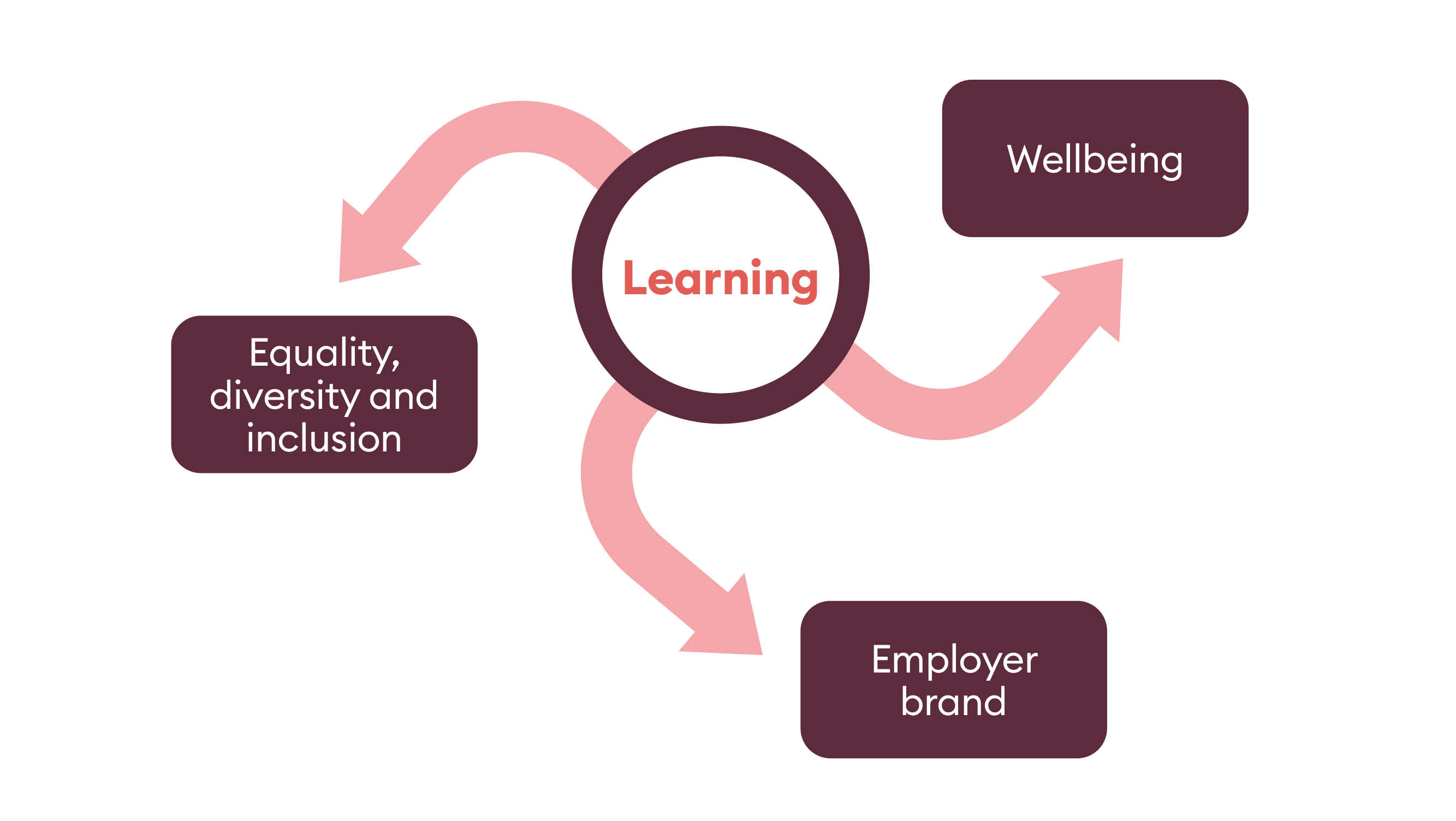
Learning and development is the most powerful talent attraction, engagement and retention tool. We are biased! But there is a reason why.
Investing in learning will support the majority of innovative employee attraction, engagement and retention strategies used by HR leaders.
Learning also answers many current employee concerns, including factors cited as causing the ‘Great Resignation’.
Global Defence and Aerospace firm Babcock International partnered with Future Talent Learning to upskill its future leaders using the Transformational Leadership Programme apprenticeship.
Babcock wanted to democratise learning across the business to all of its leaders as part of a more inclusive Babcock Academy. Its focus was to find a scalable and efficient way of upskilling existing and aspiring managers with the skills and mindset to lead in times of change and disruption.
After taking part in this activity-led programme, participants reported an improved level of confidence in their individual leadership skills, agreeing that the learning supports them in their current role and recognising the many benefits for their futures. Line managers have commented on the high-quality teaching and learning taking place, with outputs “more than exceeding expectations”.
At organisational level, the Transformational Leadership Programme has allowed Babcock to utilise the Apprenticeship Levy in England in a meaningful way. Because the programme is virtual, and therefore accessible group-wide, there is appetite to establish it globally, with decision-makers commenting that this is a “fantastic way for us to roll out an extremely high-value leadership programme across the organisation”.
Deploying the programme across the business has provided a more consistent learning experience and improved the profile of Babcock’s learning and development function at group level.
Want to read the full article at your leisure or share it with a colleague?
Enter your details and download.

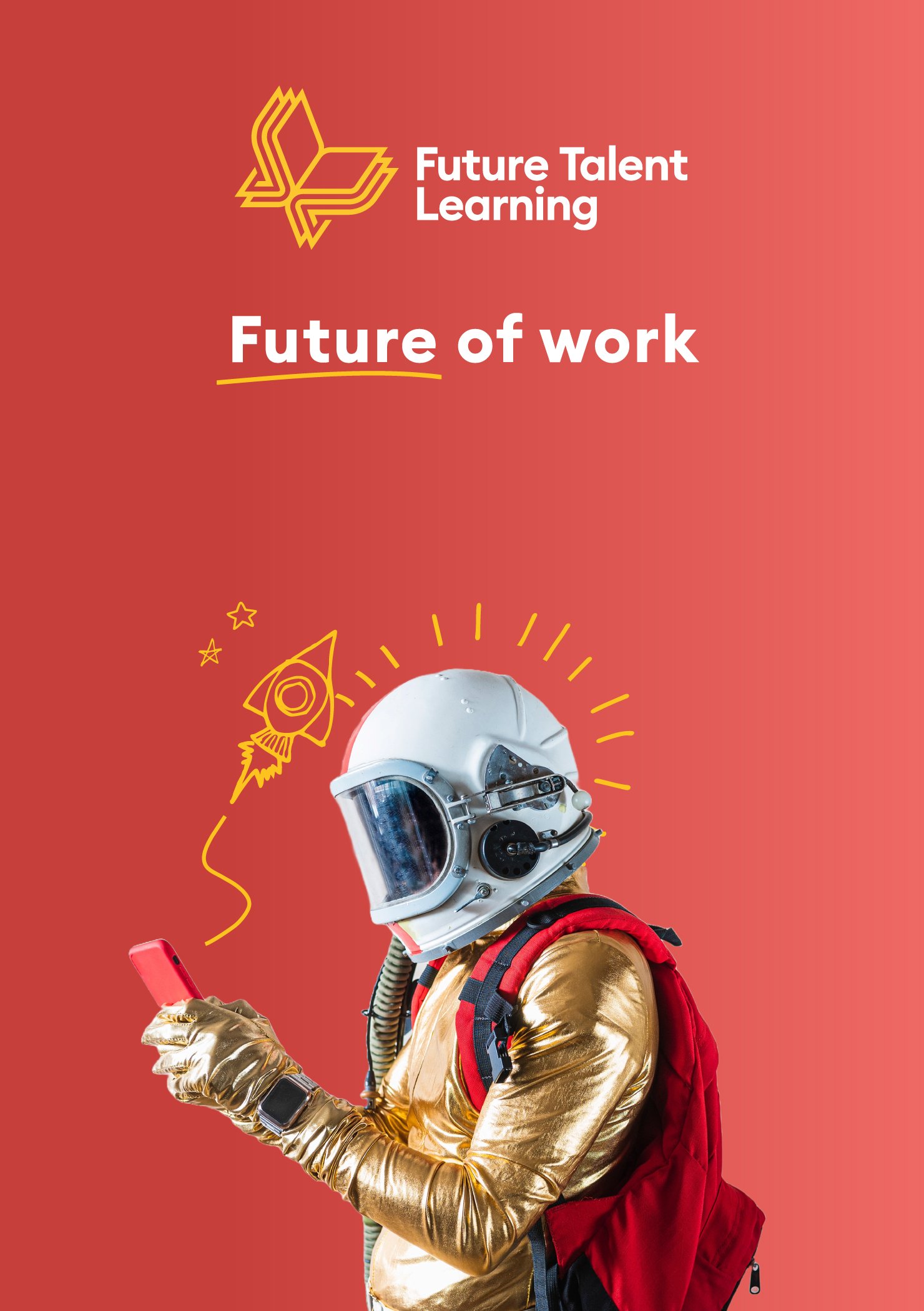



Change Board Holdings Limited,
trading as Future Talent Learning,
Main Apprenticeship Training Provider
UKPRN 10084912